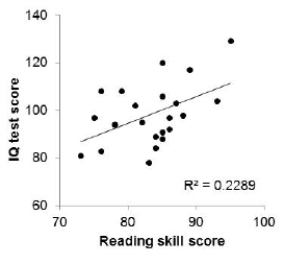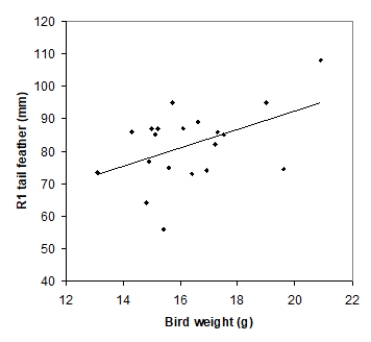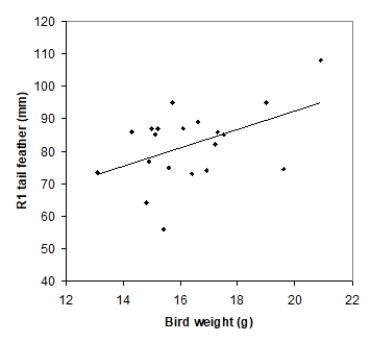A) 2.3013 ± 1.9419
B) 2.3013 ± 0.1863
C) 0.7963 ± 1.9419
D) 0.7963 ± 0.1863
Correct Answer

verified
Correct Answer
verified
Multiple Choice
Researchers found a linear relationship between tail-feather length (in mm) and weight (in g) in a random sample of 20 male long-tailed finches raised in an aviary (with weights ranging from about 13 to 21 g) . Using software, we obtain the following output for predicting feather length when weight = 20 g: What is a 95% prediction interval for the weight of one male long-tailed finch weighing 20 g?
A) 92.34 ± 5.26
B) 92.34 ± 11.04
C) 92.34 ± 12.36
D) 92.34 ± 24.72
Correct Answer

verified
Correct Answer
verified
Multiple Choice
Data on the water quality in the eastern United States were obtained by a researcher who wanted to ascertain whether the amount of particulates in water (ppm) could be used to accurately predict the water quality score. Suppose we use the following simple linear regression model: Qualityi = α+ β× particulatesi + Ɛi Where the deviations Ɛi are assumed to be independent and Normally distributed with mean 0 and standard deviation σ. This model was fit to the data using the method of least squares. The following results were obtained from statistical software based on a sample of size 61: r2 = 0.005, s = 0.7896. What is the intercept of the least-squares regression line?
A) -0.009
B) 0.020
C) 1.003
D) 6.214
Correct Answer

verified
Correct Answer
verified
Multiple Choice
Researchers want to know if reading skills can explain IQ test scores in children with dyslexia. The following scatterplot examines the relationship between reading skill score and IQ test score for 22 dyslexic children. The least-squares regression line is displayed on the plot, along with the value of r2.
 We want to test a hypothesis of no relationship between the two scores, H0: p= 0 versus Ha: p≠0.
What is the P-value for this test?
We want to test a hypothesis of no relationship between the two scores, H0: p= 0 versus Ha: p≠0.
What is the P-value for this test?
A) Less than 0.01
B) Between 0.01 and 0.05
C) Between 0.05 and 0.10
D) Greater than 0.10
Correct Answer

verified
Correct Answer
verified
Multiple Choice
A random sample of 79 patients from a walk-in clinic records the low- and high-density cholesterol levels of the patients, labeled LDL and HDL, respectively. LDL is often referred to as "bad" cholesterol, while HDL is often referred to as "good" cholesterol. A researcher is interested in fitting the following linear regression curve to LDL and HDL levels: LDLi = α+ β× HDLi + Ɛi Where the deviations Ɛi are assumed to be independent and Normally distributed with mean 0 and standard deviation σ. This model was fit to the data using the method of least squares. The following results were obtained from statistical software: r2 = 0.810, s = 50. Is there strong evidence (and if so, why?) of a straight-line relationship between LDL and HDL?
A) Yes, because the slope of the least-squares line is positive.
B) Yes, because the P-value for testing whether the slope is 0 is quite small.
C) No, because the value of the square of the correlation is relatively small.
D) It is impossible to say because we are not given the actual value of the correlation.
Correct Answer

verified
Correct Answer
verified
Multiple Choice
Tail-feather length in birds is sometimes a sexually dimorphic trait; that is, the trait differs substantially for males and for females. Researchers studied the relationship between weight (x) and tail-feather length (y) in a sample of 5 wild male long-tailed finches. Here are the data: We want to test the hypotheses H0: β= 0, versus Ha: β> 0, where βis the true value of the population slope. Using appropriate software, what is the P-value for this test?
A) Less than 0.01
B) Between 0.01 and 0.05
C) Between 0.05 and 0.10
D) Greater than 0.10
Correct Answer

verified
B
Correct Answer
verified
Multiple Choice
Tail-feather length in birds is sometimes a sexually dimorphic trait; that is, the trait differs substantially for males and for females. Researchers studied the relationship between weight (x) and tail-feather length (y) in a sample of 5 wild male long-tailed finches. Here are the data: Using appropriate software, what percentage of variation in tail-feather length can be explained by weight among male long-tailed finches in the wild?
A) 62%
B) 79%
C) 89%
D) 94%
Correct Answer

verified
Correct Answer
verified
Multiple Choice
Researchers found a linear relationship between tail-feather length (in mm) and weight (in g) in a random sample of 20 male long-tailed finches raised in an aviary (with weights ranging from about 13 to 21 g) . Using software, we obtain the following output for predicting feather length when weight = 20 g: What is a 95% confidence interval for the mean tail-feather length of all male long-tailed finches that weigh 20 g?
A) 92.34 ± 5.26
B) 92.34 ± 11.04
C) 92.34 ± 12.36
D) 92.34 ± 24.72
Correct Answer

verified
Correct Answer
verified
Multiple Choice
A fisheries biologist has been studying horseshoe crabs using categorical variables, but she has decided that reporting the data as continuous variables would be more useful. She has sampled 100 horseshoe crabs and recorded their weight (in kilograms) and width (in centimeters) . The proposed regression equation is Weighti = α+β × widthi + Ɛi Where the deviations Ɛi are assumed to be independent and Normally distributed with mean 0 and standard deviation σ. This model was fit to the data using the method of least squares. The following results were obtained from statistical software: r2 = 0.423, s = 2.2018. Suppose the researchers test the following hypotheses: H0: = β=0, Hα: β> 0 What is the value of the t statistic for this test?
A) 0.36
B) 2.35
C) 3.57
D) 8.48
Correct Answer

verified
Correct Answer
verified
Multiple Choice
A fisheries biologist has been studying horseshoe crabs using categorical variables, but she has decided that reporting the data as continuous variables would be more useful. She has sampled 100 horseshoe crabs and recorded their weight (in kilograms) and width (in centimeters) . The proposed regression equation is Weighti = α+β × widthi + Ɛi Where the deviations Ɛi are assumed to be independent and Normally distributed with mean 0 and standard deviation σ. This model was fit to the data using the method of least squares. The following results were obtained from statistical software: r2 = 0.423, s = 2.2018. Based on the sample data, what is the correlation between the width and weight of horseshoe crabs?
A) -0.650
B) -0.423
C) 0.423
D) 0.650
Correct Answer

verified
Correct Answer
verified
Multiple Choice
Tail-feather length in birds is sometimes a sexually dimorphic trait; that is, the trait differs substantially for males and for females of the same species. Researchers studied the relationship between tail-feather length (measuring the R1 central tail feather) and weight in a sample of 20 male long-tailed finches raised in an aviary. The data are displayed in the scatterplot below, followed with software output about the least-squares regression model of feather length as a function of weight.

\begin{array}{l}\begin{array} { l l r } \hline &\text {Coefficients }&\text {Standard Error }\\\hline\text {Intercept }&35.7379 & 21.0523 \\\text { Bird-weight}&2.8299 & 1.2811\\\hline\text {R Square }&0.2133\\\text {Standard Error }&\ 10.5270\\end{array}\end{array} What is the value of the slope for the least-squares regression line?
\begin{array}{l}\begin{array} { l l r } \hline &\text {Coefficients }&\text {Standard Error }\\\hline\text {Intercept }&35.7379 & 21.0523 \\\text { Bird-weight}&2.8299 & 1.2811\\\hline\text {R Square }&0.2133\\\text {Standard Error }&\ 10.5270\\end{array}\end{array} What is the value of the slope for the least-squares regression line?
A) 21.0523
B) 2.8299
C) 35.7379
D) 1.2811
Correct Answer

verified
Correct Answer
verified
Multiple Choice
A fisheries biologist has been studying horseshoe crabs using categorical variables, but she has decided that reporting the data as continuous variables would be more useful. She has sampled 100 horseshoe crabs and recorded their weight (in kilograms) and width (in centimeters) . The proposed regression equation is weighti = α+β × widthi + Ɛi Where the deviations Ɛi are assumed to be independent and Normally distributed with mean 0 and standard deviation σ . This model was fit to the data using the method of least squares. The following results were obtained from statistical software: r2 = 0.423, s = 2.2018. Suppose we use statistical software to predict the weight for a horseshoe crab with width 2.25 centimeters, which yields the following: What is a 95% confidence interval for this prediction according to this output?
A) (2.556, 5.630)
B) (-0.539, 8.725)
C) 4.093 ± 1.9419
D) 4.093 ± 0.1863
Correct Answer

verified
Correct Answer
verified
Multiple Choice
Tail-feather length in birds is sometimes a sexually dimorphic trait; that is, the trait differs substantially for males and for females of the same species. Researchers studied the relationship between tail-feather length (measuring the R1 central tail feather) and weight in a sample of 20 male long-tailed finches raised in an aviary. The data are displayed in the scatterplot below, followed with software output about the least-squares regression model of feather length as a function of weight.

\begin{array}{l}\begin{array} { l l r } \hline &\text {Coefficients }&\text {Standard Error }\\\hline\text {Intercept }&35.7379 & 21.0523 \\\text { Bird-weight}&2.8299 & 1.2811\\\hline\text {R Square }&0.2133\\\text {Standard Error }&\ 10.5270\\end{array}\end{array} Which of the following conclusions best describes the findings?
\begin{array}{l}\begin{array} { l l r } \hline &\text {Coefficients }&\text {Standard Error }\\\hline\text {Intercept }&35.7379 & 21.0523 \\\text { Bird-weight}&2.8299 & 1.2811\\\hline\text {R Square }&0.2133\\\text {Standard Error }&\ 10.5270\\end{array}\end{array} Which of the following conclusions best describes the findings?
A) There is no evidence (P > 0.10) of a linear relationship between tail-feather length and weight in male long-tailed finches.
B) There is weak evidence (0.05 < P < 0.10) of a linear relationship between tail-feather length and weight in male long-tailed finches.
C) There is significant evidence (P < 0.05) of a positive linear relationship between tail-feather length and weight in male long-tailed finches.
D) There is significant evidence (P < 0.05) that there is no linear relationship between tail-feather length and weight in male long-tailed finches.
Correct Answer

verified
Correct Answer
verified
Multiple Choice
A fisheries biologist has been studying horseshoe crabs using categorical variables, but she has decided that reporting the data as continuous variables would be more useful. She has sampled 100 horseshoe crabs and recorded their weight (in kilograms) and width (in centimeters) . The proposed regression equation is Weighti = α+β × widthi + Ɛi Where the deviations Ɛi are assumed to be independent and Normally distributed with mean 0 and standard deviation σ. This model was fit to the data using the method of least squares. The following results were obtained from statistical software: r2 = 0.423, s = 2.2018. What is the explanatory variable in this study?
A) Weight
B) Width
C) The slope, β
D) The intercept, α
Correct Answer

verified
Correct Answer
verified
True/False
To estimate the mean response, we use a prediction interval.
Correct Answer

verified
Correct Answer
verified
Multiple Choice
Tail-feather length in birds is sometimes a sexually dimorphic trait; that is, the trait differs substantially for males and for females. Researchers studied the relationship between weight (x) and tail-feather length (y) in a sample of 5 wild male long-tailed finches. Here are the data: We want to test the hypotheses H0: β= 0, versus Ha: β> 0, where βis the true value of the population slope. Using appropriate software, what is the value of the t statistic for this test?
A) 0.89
B) 2.81
C) 3.34
D) 3.74
Correct Answer

verified
C
Correct Answer
verified
Short Answer
Researchers examined hormonal changes in 39 women during the menopausal years. They found a weak linear relationship between age (in years) and the six-month percent change in plasma level of the reproductive hormone LH (luteinizing hormone). Software gives the following output for a least-squares regression analysis: S = 41.5236 R-Sq = 2.9% R-Sq(adj) = 0.2% Based on this output, the P-value for testing the hypotheses H0: β1 = 0 versus Ha: β1 ≠ 0 is ______________.
Correct Answer

verified
Correct Answer
verified
Multiple Choice
Tail-feather length in birds is sometimes a sexually dimorphic trait; that is, the trait differs substantially for males and for females. Researchers studied the relationship between weight (x) and tail-feather length (y) in a sample of 5 wild male long-tailed finches. Here are the data: Using appropriate software to perform the necessary calculations, what does the value of the slope for the least-squares regression line tells us?
A) For every 1 g change in weight, tail length increases by 0.280 mm, on average.
B) For every 1 g change in weight, tail length increases by 2.81 mm, on average.
C) For every 1g change in weight, tail length increases by 0.789 mm, on average.
D) For every 1 g change in weight, tail length increases by 25.547 mm, on average.
Correct Answer

verified
Correct Answer
verified
Multiple Choice
Data on the water quality in the eastern United States were obtained by a researcher who wanted to ascertain whether the amount of particulates in water (ppm) could be used to accurately predict the water quality score. Suppose we use the following simple linear regression model: Qualityi = α+ β× particulatesi + Ɛi Where the deviations Ɛi are assumed to be independent and Normally distributed with mean 0 and standard deviation σ. This model was fit to the data using the method of least squares. The following results were obtained from statistical software based on a sample of size 61: r2 = 0.005, s = 0.7896. Is there strong evidence (and if so, why?) that there is a straight-line dependence between the amount of particulates and water quality?
A) Yes, because the slope of the least-squares line is not zero.
B) Yes, because the confidence interval for the slope includes zero.
C) No, because the confidence interval for the slope includes zero.
D) It is impossible to say because we are not given the actual value of the correlation.
Correct Answer

verified
C
Correct Answer
verified
Multiple Choice
A random sample of 79 patients from a walk-in clinic records the low- and high-density cholesterol levels of the patients, labeled LDL and HDL, respectively. LDL is often referred to as "bad" cholesterol, while HDL is often referred to as "good" cholesterol. A researcher is interested in fitting the following linear regression curve to LDL and HDL levels: LDLi = α+ β× HDLi + Ɛi Where the deviations i are assumed to be independent and Normally distributed with mean 0 and standard deviation . This model was fit to the data using the method of least squares. The following results were obtained from statistical software: r2 = 0.810, s = 50. What is the intercept of the least-squares regression line?
A) 0.025
B) 0.75
C) 3
D) -25
Correct Answer

verified
Correct Answer
verified
Showing 1 - 20 of 45
Related Exams